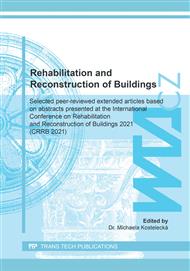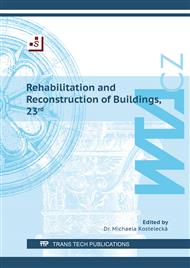[1]
R. Lenner, P. Ryjacek, and M. Sykora, Resistance models for semi-probabilistic assessment of historic steel bridges, in IABSE Symposium, Wroclaw 2020: Synergy of Culture and Civil Engineering - History and Challenges, Report, 2020, p.1061–1068.
DOI: 10.2749/wroclaw.2020.1061
Google Scholar
[2]
M. Sykora, J. Mlcoch, and P. Ryjacek, Uncertainties in Characteristic Strengths of Historic Steels Using Non-Destructive Techniques, Trans. VSB - Tech. Univ. Ostrava, Civ. Eng. Ser., vol. 19, no. 2, p.65–70, 2019,.
Google Scholar
[3]
ISO 2394, General Principles on Reliability for Structures, 4th ed. Geneve, Switzerland: ISO, (2015).
Google Scholar
[4]
CEN/TC 250/WG 2, prEN1990-2 Eurocode - Basis of assessment and retrofitting of existing structures: general rules and actions (draft April 2021). (2021).
Google Scholar
[5]
M. Holický and M. Sýkora, Reliability Approaches Affecting the Sustainability of Concrete Structures, Sustainability, vol. 13, no. 5, 2021,.
DOI: 10.3390/su13052627
Google Scholar
[6]
J. Bien, L. Elfgren, and J. Olofsson, Sustainable Bridges. Assessment for Future Traffic Demands and Longer Lives. 490 pp. Available as D9.2 from www.sustainablebridges.net. (2007).
Google Scholar
[7]
R. D. J. M. Steenbergen, M. Sýkora, D. Diamantidis, M. Holický, and T. Vrouwenvelder, Economic and human safety reliability levels for existing structures, Struct. Concr., vol. 16, no. 3, p.323–332, 2015, doi: https://doi.org/10.1002/suco.201500022.
DOI: 10.1002/suco.201500022
Google Scholar
[8]
EN 1990, Eurocode - Basis of structural design. CEN, Brussels, p.87, (2002).
Google Scholar
[9]
ISO 13822, Bases for design of structures - Assessment of existing structures. Geneve, Switzerland: ISO TC98/SC2, (2010).
Google Scholar
[10]
CEN/TC 250, prEN1990. Eurocode - Basis of structural design. Annex A.2. Application for bridges (draft 2019-10). (2019).
Google Scholar
[11]
ČSN 730038, Navrhování konstrukcí - Doplňující ustanovení pro hodnocení existujících konstrukcí. Praha: ČAS (Czech Standardization Agency), (2019).
Google Scholar
[12]
M. Holicky, D. Diamantidis, and M. Sykora, Reliability levels related to different reference periods and consequence classes, Beton- und Stahlbetonbau, vol. 113, no., p.22–26, (2018).
DOI: 10.1002/best.201800039
Google Scholar
[13]
FIB Bulletin 65, FIB Model Code 2020, draft. (2021).
Google Scholar
[14]
SŽ S5/1, Diagnostika , zatížitelnost a přechodnost železničních mostních objektů (Diagnostics, load-bearing capacity and transitability of railway bridge structures). (2021).
Google Scholar
[15]
M. Holicky, Introduction to Probability and Statistics for Engineers. Berlin: Springer-Verlag, (2013).
Google Scholar
[16]
V. N. Moreira, J. Fernandes, J. C. Matos, and D. V Oliveira, Reliability-based assessment of existing masonry arch railway bridges, Constr. Build. Mater., vol. 115, p.544–554, (2016).
DOI: 10.1016/j.conbuildmat.2016.04.030
Google Scholar
[17]
D. F. Wisniewski, J. R. Casas, and M. Ghosn, Simplified probabilistic non-linear assessment of existing railway bridges, Struct. Infrastruct. Eng., vol. 5, no. 6, p.439–453, (2009).
DOI: 10.1080/15732470701639906
Google Scholar
[18]
V. Nadolski and M. Sykora, Uncertainty in Resistance Models for Steel Members, Trans. VŠB – Tech. Univ. Ostrava, Civ. Eng. Ser., vol. 14, no. 2, p.26–37, 2015,.
DOI: 10.2478/tvsb-2014-0028
Google Scholar
[19]
CEN TC250/ Ad Hoc Group Reliability of Eurocodes (convenor - Ton Vrouwenvelder) Technical Report for the reliability background of Eurocodes. Draft June 2021. p.165, (2021).
Google Scholar
[20]
JCSS, JCSS Probabilistic Model Code (periodically updated, online publication). Joint Committee on Structural Safety, (2021).
Google Scholar
[21]
M. Sykora, M. Holicky, J. Markova, and T. Senberger, Probabilistic Reliability Assessment of Existing Structures (Focused on Industrial Heritage Buildings), 1st ed. Prague: Czech Technical University in Prague, CTU Publishing House, (2016).
Google Scholar



